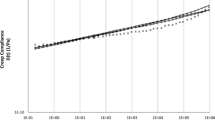Abstract
An algorithm for the calculation of discrete, logarithmic equidistant retardation spectra from creep or recovery is applied to experimental data in different regions of consistency. Spectra in the glass-rubber transition region are given for technical poly(styrene), poly(methylmethacrylate), and poly(carbonate) as well as the course of all characteristic compliance type functions. The spectrum in the terminal region of a poly(styrene) of narrow molecular weight distribution is calculated both from creep and recovery data. The course of the dynamic moduli calculated from the spectra and by direct conversion is found in excellent agreement to measurements by means of a dynamic viscometer.
Similar content being viewed by others
References
Baumgärtel M, Winter HH (1992) Interrelation between continuous and discrete relaxation time spectra. J NonNewt Fluid Mech 44:15 – 36
Graessley WW (1974) The entanglement concept in polymer rheology, chap 5. Adv Polym Sci 16, Springer Berlin
Kaschta J, Schwarzl FR (1994) Calculation of discrete retardation spectra from creep data — I. Method, Rheol Acta (this volume)
Kaschta J (1991) Zum Nachgiebigkeitsverhalten amorpher Polymere im Glas-Kautschuktibergang. Thesis, Erlangen
Link G, Schwarzl FR (1985) A measuring device for the precise evaluation of creep and recovery data. Rheol Acta 24:211–219
Montfort JP, Marin G, Monge P (1984) Effects of constraint release on the dynamics of entangled linear polymer melts. Macromolecules 17:1551–1560
Nederveen CJ, van der Wal CW (1968) A torsional pendulum for the determination of shear modulus and damping around 1 Hz. Rheol Acta 6:316–323
Orbon SJ, Plazek DJ (1979) Recoverable compliance of a series of bimodal molecular weight blends of polystyrene. J Polym Sci Phys Ed 17:1871–1890
Plazek DJ, O'Rouke VM (1971) Viscoelastic behaviour of low molecular weight polystyrene. J Polym Sci A-2 8:209 – 243
Schwarzl FR, Staverman AJ (1952) Higher approximations of relaxation spectra. Physica 18:791–799
Schwarzl FR (1969) The numerical calculation of storage and loss compliance from creep data for linear viscoelastic materials. Rheol Acta 8:6–17
Schwarzl FR (1970) On the interconversion of linear viscoelastic material functions. Pure and Appl Chem 23:219 – 234
van der Wal CW, Drent RHJWA (1969) A torsional creep apparatus. Rheol Acta 7:265–271
Wolf M (1992) Zur Molekulargewichtsabhängigkeit des rheologischen Verhaltens von PS und PMMA unterschiedlicher Molekularmassenverteilung. Thesis Erlangen
Author information
Authors and Affiliations
Additional information
Dedicated to Prof. Dr. H. Janeschitz-Kriegl at the occassion of his 70th birthday.
Rights and permissions
About this article
Cite this article
Kaschta, J., Schwarzl, F.R. Calculation of discrete retardation spectra from creep data — II. Analysis of measured creep curves. Rheol Acta 33, 530–541 (1994). https://doi.org/10.1007/BF00366337
Received:
Issue Date:
DOI: https://doi.org/10.1007/BF00366337




